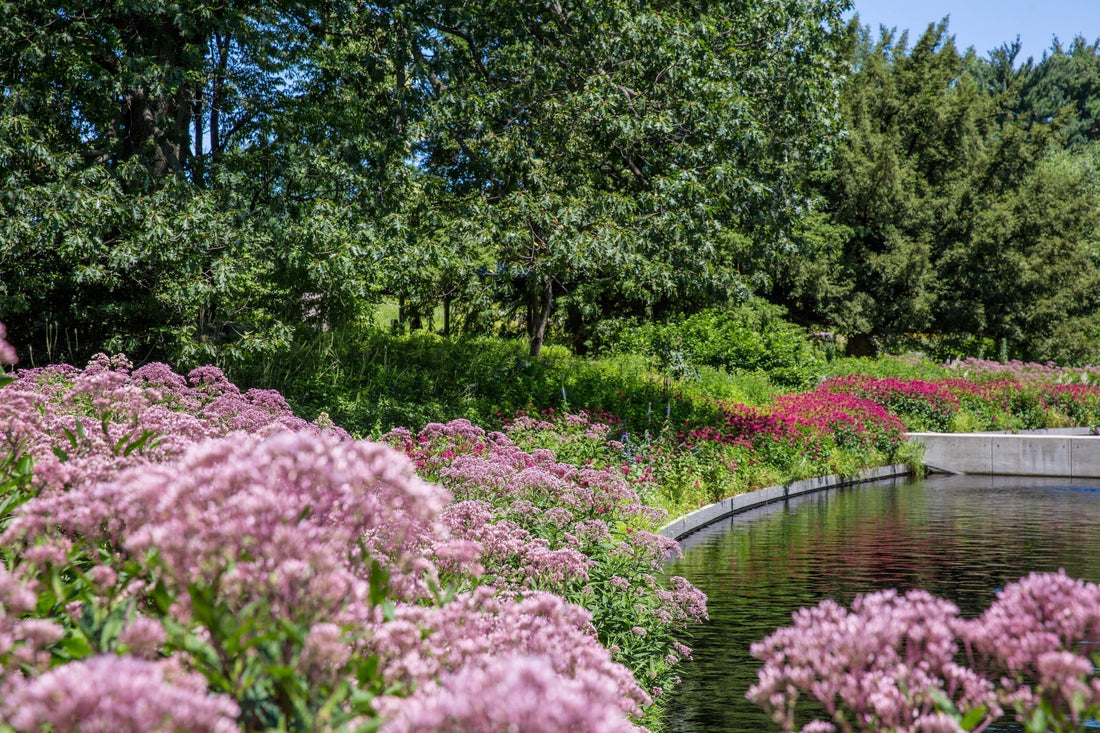
Outdoor Care
Tips for a Climate-Smart Garden with The Sill & NYBG
At The Sill, we believe plants do more than brighten our homes—they connect us to the natural world and play a powerful role in supporting healthier communities. That’s why we’ve partnered with the New York Botanical Garden to share sustainable gardening tips on creating a climate-smart garden—one that’s beautiful, resilient, and beneficial to local ecosystems.

Tips At a Glance
- Plant native species and perennials that support pollinators, birds, and local wildlife.
- Think big with trees—they cool neighborhoods, capture carbon, and create habitat.
-
Gardens give back by improving air, water, and community resilience.
- Climate-smart means low-maintenance! Beautiful spaces that thrive while helping the planet.
What is a Climate-Smart Garden?
A climate-smart garden is more than just a beautiful outdoor space—it’s a space that gives back. By planting natives suited to your region, you’re helping pollinators, birds, and other local wildlife while cutting down on extra water and fertilizer. Add in perennials and you’ll build strong root systems that boost soil health, capture carbon, and keep the landscape thriving. Together, they create a garden that’s resilient, easy to care for, and good for both your home and the planet.
Along with choosing your plants wisely, your garden practices also make a huge impact. Skip harsh chemical pesticides and opt for organic insect controls that are safer for pollinators and people. Let fallen leaves work for you this fall—use them as mulch to insulate soil, return nutrients, and support beneficial insects, or pile them to create winter habitats!
Start With Native Plants
When planning your garden, prioritize native species—plants that naturally grow in your region. Native plants are already adapted to local soil and climate conditions, meaning they require less water, fertilizer, and maintenance to thrive. Even better, they provide food and shelter for pollinators, birds, and other wildlife that have co-evolved alongside them. Planting natives creates a ripple effect: you’re not just supporting your own garden, you’re helping sustain an entire web of life.
NYBG’s plant experts recommend looking to their Native Plant Garden for inspiration, where standouts like Joe-Pye Weed (Eutrochium purpureum), Big Bluestem (Andropogon gerardii), and Northern spicebush (Lindera benzoin) thrive. These species aren’t just beautiful but they also provide food and habitat for pollinators, birds, and other wildlife, making them excellent choices for creating a climate-smart garden at home!
Choose Perennials and Trees
While annuals can be fun for seasonal color, perennials are a climate-smart choice because they come back year after year. They develop stronger root systems over time, helping improve soil health, prevent erosion, and capture more carbon. They also reduce waste, since you don’t need to replant them every season. Trees and shrubs are especially impactful, offering shade, cooling surrounding areas, and providing long-term habitats for wildlife.
A few of our favorites include Wisteria and Eastern Redbud which produce vibrant flowers in spring that attract bees, butterflies, and other pollinators, supporting a healthy, thriving ecosystem. Other perennials like Coreopsis and Black-Eyed Susans are drought-tolerant, low-maintenance, and add long-lasting color with cheerful blooms that pollinators also love.
Looking for greenery that lasts all year? Try an evergreen tree like the Nellie Stevens Holly which stays vibrant through every season, offering dense shelter and bright berries as seasonal food for birds!
Support Ecosystem Services
Every plant you choose contributes to what scientists call ecosystem services—the natural processes that benefit both people and the planet. By creating a garden rich with natives, perennials, and trees, you’re helping to:
-
Clean and filter air
-
Improve water quality by reducing runoff
-
Provide nectar and pollen for pollinators
-
Offer food and shelter for beneficial insects and birds
-
Store carbon and help mitigate climate change
These may sound like big ideas, but they all start small, either in your backyard, balcony, or community garden!
Think Community, Not Just Curb Appeal
A climate-smart garden is more than a personal oasis. It’s part of a larger network of green spaces that make neighborhoods more livable, resilient, and connected. From providing shade on hot summer days to offering safe havens for wildlife, your garden is a gift to your community as much as it is to yourself.

Where to Begin
Start by researching which native plants, shrubs, and trees are best suited for your region. Many botanical gardens and local organizations offer helpful plant lists and resources. Then, mix in perennials and trees for long-lasting greenery, and consider layering in different plant heights such as ground covers, flowering perennials, shrubs, and trees to maximize biodiversity.
By choosing your plants wisely, you’ll grow a space that’s lush, low-maintenance, and ecologically powerful. Together with NYBG, we’re proud to encourage planting choices that help both your home and our planet thrive!

Words By The Sill
Empowering all people to be plant people—a collection of articles from The Sill's team of plant experts across a variety of plant care topics to inspire confidence in the next generation of plant parents. Welcome to Plant Parenthood™.
Do Some Plant Shopping